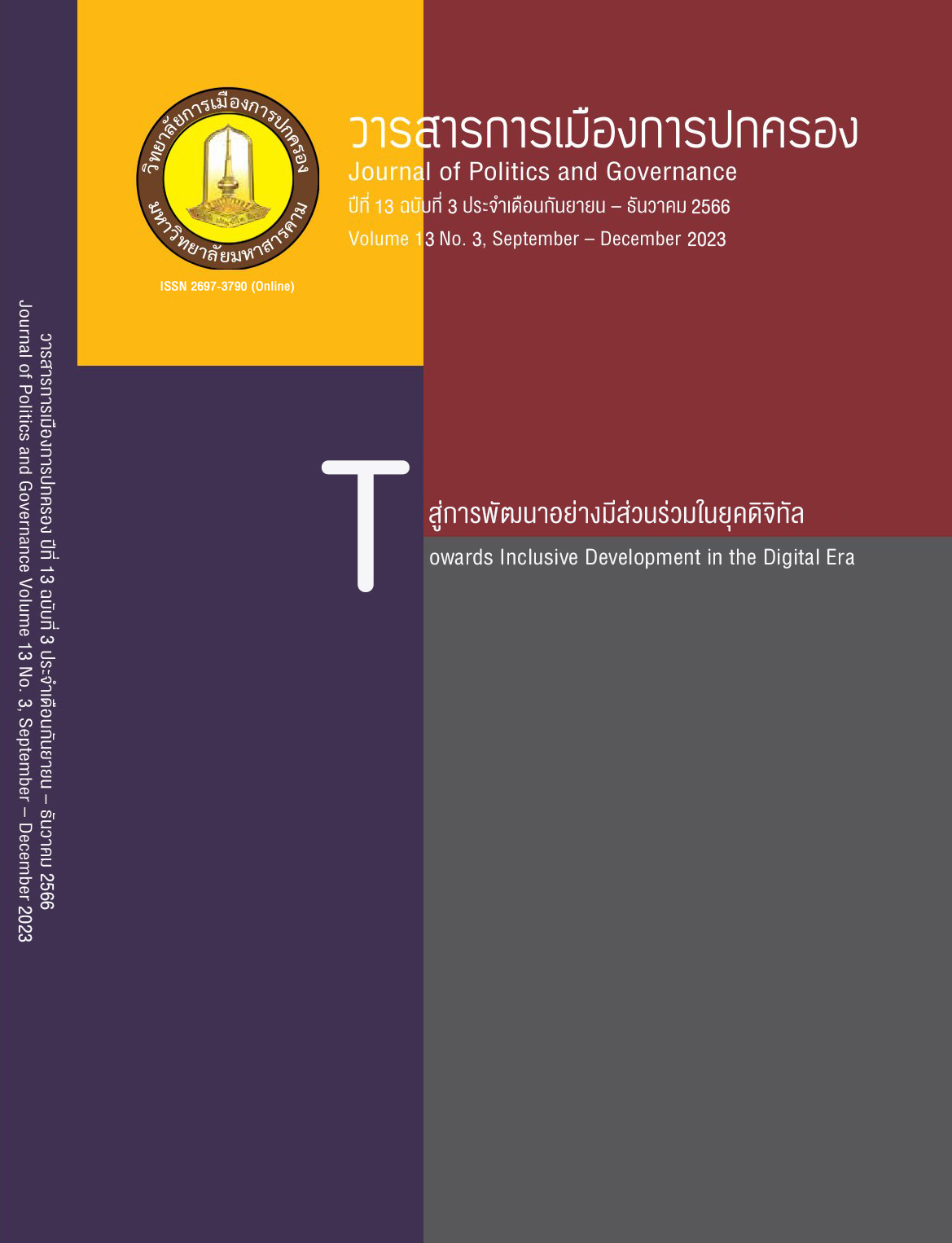The Impact of South China Sea Dispute on ASEAN Centrality
Main Article Content
Abstract
ASEAN centrality strategy is the core of ASEAN in relations with external countries. especially great power also known as ASEAN as regional architecture. The main characteristic of such strategies ASEAN is the center of regional relations networks. Playing a leading role through institutions initiated by ASEAN as a facilitator of negotiations by providing an assortment of multilateralism consultative mechanisms. ASEAN assumes the prime node in the regional architecture, ensuring that it would not be marginalized by other emerging regional arrangements and as a central unity among ASEAN member states. The status of the core of ASEAN has been evident since the promulgation of the ASEAN Charter in 2008. However, ASEAN centrality is being challenged by the conflict in the South China Sea between some ASEAN members and China. This study, uses the constructivism approach and argues that conflict between ASEAN and China in the South China Sea has led to a lack of unity within ASEAN due to expressing different opinions between members even making the solution to such problems cannot be initiated and implemented using ASEAN as the center. The main case study is that in 2012 ASEAN was unable to issue a Joint Statement of The 45th ASEAN Foreign Ministers' Meeting in Cambodia. (Caballero-Anthony, 2022).
Article Details

This work is licensed under a Creative Commons Attribution-NonCommercial-NoDerivatives 4.0 International License.
References
กระทรวงการต่างประเทศ. (2562). การประชุมรัฐมนตรีอาเซียน-จีน. สำนักงานเลขาธิการอาเซียนแห่งชาติ. https://www.asean2019.go.th/th/news/asean-china-ministerial-meeting-2/
กระทรวงการต่างประเทศ. (2551). กฎบัตรอาเซียน. กรุงเทพฯ: เพจเมคเกอร์.
กิตติมัย ธนณาเคนทร์. (2561). Soft Power ของจีนในศตวรรษที่ 21. จุลสารความมั่นคงศึกษา, 195, 1-22.
วิศรา ไกรวัฒนพงศ์, และวรศักดิ์ มหัธโนบล. (2559). ความขัดแย้งในทะเลจีนใต้. จุลสารความมั่นคงศึกษา, 172-173, 1-66.
สถานทูตสหรัฐฯ และสถานกงสุลประจำประเทศไทย. (2565). ยุทธศาสตร์อินโด-แปซิฟิกของสหรัฐอเมริกา. https://th.usembassy.gov/th/us-indo-pacific-strategy-th
สัญญารัตน์ มีสุวรรณ. (2562). โครงการการแข่งอิทธิพลระหว่างสหรัฐอเมริกากับจีนในทะเลจีนใต้ และทะเลจีนตะวันออก ระหว่าง พ.ศ. 2552 ถึง พ.ศ. 2560: ผลกระทบและข้อเสนอแนะต่อประเทศไทย (รายงานการวิจัย). https://elibrary.trf.or.th/project _content.asp?PJID=RDG6010048
Acharya, A. (2003). Regionalism and Multilateralism: Essays on Cooperative Security in the Asia-Pacific. Eastern Universities Press.
Acharya, A. (2017). The myth of ASEAN centrality? Contemporary Southeast Asia: A Journal of International and Strategic Affairs, 39(2), 273-279.
ASEAN Regional Forum. (2009). ASEAN Regional Forum Vision Statement. https://aseanregionalforum.asean.org/wp-content/uploads/2018/07/ARF-Vision-Statement-2009.pdf
ASEAN Secretariat. (2015). Chairman’s Statement of the 3rd ASEAN Defence Ministers’ Meeting-Plus. https://asean.org/chairmans-statement-of-the-3rd-asean-defence-ministers-meeting-plus-3rd-admm-plus-kuala-lumpur-4-november-2015/
Basilio, B. (2012, July 19). What Happened in Phnom Penh? The Philippine Star. https://www.philstar.com/headlines/2012/07/19/829282/ what-happened-phnom-penh
Bomping, C., U. (2020, October 2). A Storm Ahead for the ASEAN-China Code of Conduct Negotiations. The Geopolitics. https://thegeopolitics.com/a-storm-ahead-for-the-asean-china-code-of-conduct-negotiations
Caballero-Anthony, M. (2014). Understanding ASEAN's centrality: bases and prospects in an evolving regional architecture. The Pacific Review, 27(4), 563-584.
Caballero-Anthony, M. (2017). ASEAN Centrality tested. In S. Ganguly, A. Scobell & J. Liow (Eds.), The Routledge Handbook of Asian Security Studies (pp. 217-228). Routledge.
Caballero-Anthony, M. (2022). The ASEAN way and the changing security environment: navigating challenges to informality and centrality. International Politics, 1-21.
Choong, W. (2019). The return of the Indo-Pacific strategy: an assessment. Australian Journal of International Affairs, 73(5), 415-430.
De Castro, R. (2017). The ASEAN Regional Forum in the Face of Great-Power Competition in the South China Sea: The Limit of ASEAN's Approach in Addressing 21st-Century Maritime Security Issues? https://www.kas.de/c/document _library/get_file?uuid=43dafd95-a5cc-e07e-6d14-73ac2d12cda6&groupId =288143
Emmers, R. (2010). The changing power distribution in the South China Sea: Implications for conflict management and avoidance. Political Science, 62(2), 118-131.
Emmers, R. (2014). ASEAN's search for neutrality in the South China Sea. Asian Journal of Peacebuilding, 2(1), 61-77.
Emmerson. D, K. (2012, July 23). ASEAN stumbles in Phnom Penh. https://www.eastasiaforum. org/2012/07/23/asean-stumbles-in-phnom-penh-2/
Greer, T. (2020). China’s Plans to Win Control of the Global Order. https://www.tabletmag.com/sections/news/articles/china-plans-global-order
Gerstl, A. (2017). The South China Sea Dispute: A Shift to a More Proactive Role in ASEAN’s Discourse and Policies since 2012?. In G. Alfred & S. Mária (Eds.), Unresolved Border, Land and Maritime Disputes in Southeast Asia (pp.183-230). Leiden and Boston.
Jackson, R. & Sorensen, G. (2013). Introduction to international relations: Theories and approaches. Oxford University Press.
Jones, L. (2010). ASEAN's unchanged melody? The theory and practice of ‘non-interference in Southeast Asia. The Pacific Review, 23(4), 479-502.
Mearsheimer, J. (2010). The Gathering Storm: China’s Challenge to US Power in Asia. The Chinese Journal of International Politics, 3(4), 381-396.
Pitsuwan, S. (2009). Building an ASEAN Economic Community in the heart of East Asia. In keynote speech delivered at the East Asia Beyond the Global Economic Crisis international symposium, Tokyo, December. https://www.ide.go.jp/library/Japanese/Event/Sympo/pdf/2009/surin_en.pdf
Raditio, K. H., Raditio, & Daryanomel. (2019). Understanding China's Behaviour in the South China Sea. Singapore: Springer Singapore.
Reus-Smith, C. (2013). Constructivism. In S. Buuchill, A. Linklater, R. Devetak, J. Donnelly, T. Nardin, M. Paterson, C. reus-Smith & J. True (eds.), Theories of international relations (pp. 217-240). Basingstoke: Palgrave.
Schuman, M. (2020). China’s Plans to Win Control of the Global Order What Happens When China Leads the World. https://www.theatlantic.com/international/archive/2020/10/what-kind-superpower-will-china-be/616580
Suporn, T. (2019). The US-China Power Rivalries in the Obama Era: The Limits of American Alliance and the Challenges of (Not) Choosing Sides in Southeast Asia. Thai Journal of East Asian Studies, 23(1), 304-322.
Storey, I. (2020). The South China Sea Dispute in 2020-2021. ISEAS Perspective. https://www.iseas.edu.sg/wp content/uploads/2020/08 /ISEAS _Perspective_2020 _97.pdf
Tan, S. S., & Kemburi, K. (2014). Introduction to the Special Issue-China-US Relations and Regional Order in the Era of Rebalancing: Asia-Pacific Perspectives. Issues and Studies, 50(3), 1.
Tay, S., & Tan, C. (2015). ASEAN centrality in the regional architecture. Policy Brief. http://www.siiaonline.org/wp-content/uploads/2016/10/2015-05-Policy-Brief-ASEAN-Centrality-in-the-Regional-Architecture.pdf
Thayer, C. A. (2021). The South China Sea in Multilateral Forums: Five Case Studies. In: Buszynski, L., Hai, D.T. (Eds.), Maritime Issues and Regional Order in the Indo-Pacific. Palgrave Studies in Maritime Politics and Security (71-86). Palgrave Macmillan, Cham.
The department of defense. (2019). Indo-pacific strategy report 2019. https://media.defense. gov/2019/Jul/01/2002152311/-1/-1/1/DEPARTMENT-OF-DEFENSE-INDO-PACIFIC-STRATEGY-REPORT-2019.PDF
The National Institute for Defense Studies. (2019). NIDS China Security Report 2019. http://www.nids.mod.go.jp/english/publication/chinareport/index.html
Yukawa, T. (2018). The ASEAN way as a symbol: An analysis of discourses on the ASEAN norms. The Pacific Review, 31(3), 298-314.
Yuzawa, T. (2012). The ASEAN Regional Forum: challenges and prospects. In M. Beeson & R. Stubb (Eds.), Routledge handbook of Asian regionalism (351-362). Routledge.


